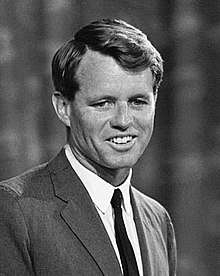Boiler Room Girls
The "Boiler Room Girls" were a team of female staff members who worked in Senator Robert F. Kennedy's 1968 presidential campaign.
Role of "boiler room" team
The term "boiler room" was applied to a windowless work area in Senator Kennedy's Washington, DC electoral offices. It contained desks divided by regions of the country, for example Northeast for Massachusetts, Connecticut, Vermont, New Hampshire, Maine. Each "girl" was assigned a regional desk and was responsible for daily communication in and out of the Washington campaign headquarters to each state director in their region. Issues and problems were discussed daily[1] and at the end of the day a decision book was compiled and sent to Kennedy and the campaign manager, Stephen Smith. Decisions were reached on each daily issue and the following morning those decisions came out from the regional desk officer ("boiler room girl") to the state director. As each state primary was held, the desk officers kept track of Kennedy's delegate count against Democratic primary contenders Eugene McCarthy and Hubert Humphrey.
Just before the 1968 Democratic National Convention, the boiler room was to be moved to a temporary office adjoining the convention floor where the same delegate officers met with the same state leaders. Following the assassination of Robert F. Kennedy on June 5, 1968, the boiler room team wound up the campaign coordination work for which they had been responsible, before dispersing to work in other offices on Capitol Hill or elsewhere in Washington. They were variously described as "frighteningly intelligent, politically astute, capable as all get-out"[2] as well as "uniformly bright, efficient, fascinated by politics".[3] The group remained in contact and were brought together for several reunions prior to that on Chappaquiddick Island in 1969, which ended with the death of "boiler room" team member Mary Jo Kopechne.
Team members
Six of the "boiler room girls", listed in descending order of age in 1968, were the following:
- Mary Jo Kopechne, 28, who died one year after Kennedy's campaign, off Chappaquiddick Island in 1969 in a highly publicized and controversial car accident involving her driver, Senator Edward M. Kennedy, who pleaded guilty after leaving the scene of an accident. All five of the campaign staff members named below were called to give evidence at a closed inquest into the incident, held in Edgartown, Massachusetts, January 5–8, 1970;[4]
- Mary Ellen Lyons, a graduate of Regis College in Weston, Massachusetts, sister of Nance Lyons, and now a practicing attorney in Boston;
- Nance Lyons, 26, a graduate of College of the Sacred Heart in Newton, Massachusetts, sister of Mary Ellen Lyons, and now a practicing attorney in Boston;
- Esther Newberg, 26, now a New York City literary agent and executive;
- Susan Tannenbaum, 24, now a retired lobbyist in Washington, D.C., and wife of a Washington lawyer; and
- Rosemary "Cricket" Keough (now Rosemary Keough Redmond Kerrebrock), 23, a graduate of Manhattanville College and Boston University who went on to be partner in a law firm in Lincoln, Massachusetts with her husband.
Aftermath
In the aftermath of Chappaquiddick, the members of this group generally avoided press interviews or other commentary. In a recorded discussion undertaken by the Edward M. Kennedy Institute in 2008, one former member of the "boiler-room" team gave brief details of the professional and personal impact of the incident on the women present.[5]
References
- ↑ https://web.archive.org/web/20060220185251/http://www.fatboy.cc:80/live_from_chappaquiddick.htm
- ↑ Cadden, Vivian (August 1974). "What Happened at Chappaquiddick". McCall's. Vol. 102. p. 80. ISSN 1060-1201.
The young women themselves – Mary Jo, the two Lyons sisters, Nance and Maryellen, Esther Newberg, "Cricket" Keough, and Susan Tannenbaum – can best be described as impressive, [c]ollege-educated, frighteningly intelligent, politically astute, capable as all get-out, a little tough, perhaps.
- ↑ "Who's Who at the Kennedy Inquest". Time. Vol. 94 no. 10. September 5, 1969. p. 28. ISSN 0040-781X. Archived from the original on October 1, 2007.
The five girls who attended the cookout are uniformly bright, efficient, fascinated by politics and cultishly pro-Kennedy.
- ↑ Pinney, Bill (2017). "Chronology". Chappaquiddick Speaks (2nd ed.). Coconut Grove: Stormy Weather Press. p. i. ISBN 978-0-692-94376-2. LCCN 2017913461. OCLC 1018310645.
- ↑ https://www.emkinstitute.org/resources/nance-lyons
